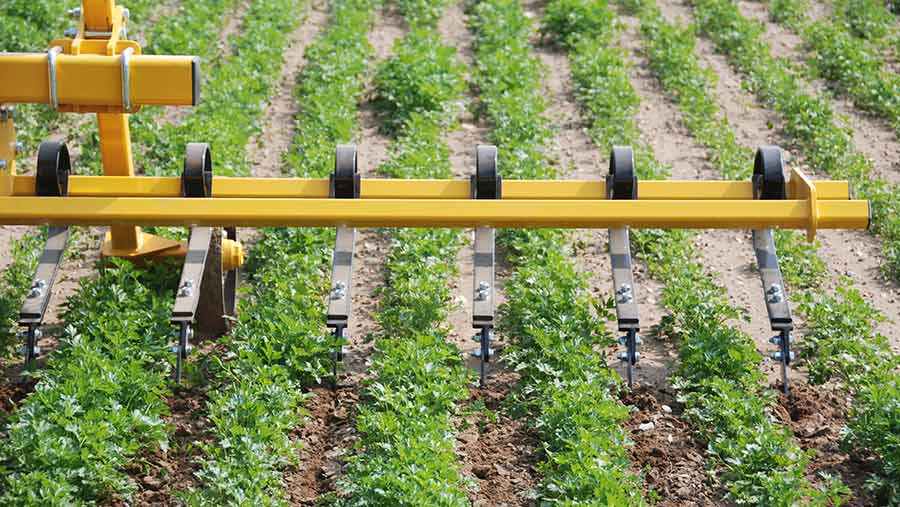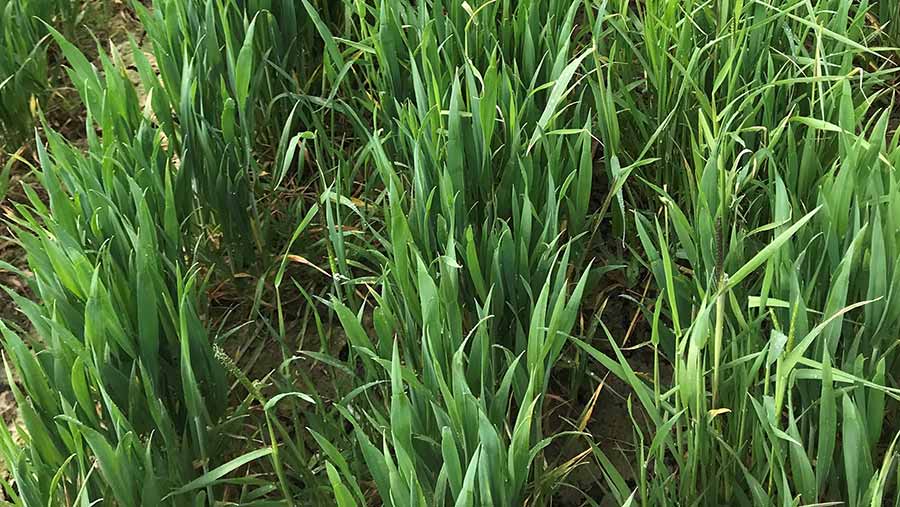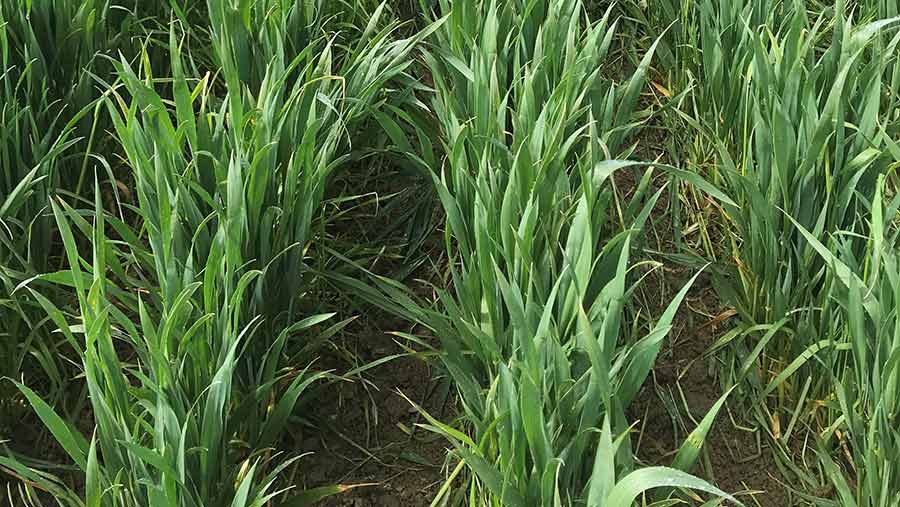Cereal grower to ditch herbicides for inter-row hoe
 TerraBlade
TerraBlade Oxfordshire growers Alan and Richard Smith plan to cut their use of herbicides in winter wheat and spring barley after achieving great blackgrass control with a mechanical hoe.
Post-emergence sprays are set to be reduced in winter wheat, and pre-emergence herbicides dropped altogether in spring barley in favour of a Claydon Terrablade after the inter-row hoe saved a crop of milling wheat from being destroyed last season due to overwhelming blackgrass levels.
The pair farm 809ha of both owned and contracted land in north Oxfordshire, with blackgrass a problem in certain areas.
See also: Targeted Adas strategy wins season-long fungicide challenge
One field had been cropped with spring barley for three years, followed by winter beans, in an effort to control bad blackgrass in a 1.6ha area of the field.
Blackgrass had been allowed to build up in this area as it used to be in an environmental scheme.
Despite spring cropping for several seasons, when the field was placed back into winter wheat for the first time, blackgrass threatened the viability of the crop in the small areas of the field which are clay-capped.
The Smiths’ Velcourt independent agronomist, Kieran Walsh, says the crop was drilled into a really nice seed-bed, and a robust pre-emergence programme achieved a good reduction of the blackgrass.
However, in February, a whole new flush of blackgrass germinated, and Mr Walsh did not believe a post-emergence spray of iodosulfuron + mesosulfuron would achieve complete control.
“I was not prepared to spend the money on a post-em that was likely to achieve less than 10-15% control,” says Mr Walsh.
TerraBlade trial
Handily, Claydon had just produced an inter-row hoe that matched the farm’s existing Claydon drill, so the Smiths took delivery of the new TerraBlade late in the season to trial.
“When it was a really bad blackgrass year a few years ago, I started looking at what organic farmers were doing to control blackgrass.
“We have to find some way of controlling blackgrass without the can, and then Claydon brought out the TerraBlade,” says Alan.
Despite the risk of damaging the wheat crop by using it at the start of May, it was decided to give mechanical weeding a try in an attempt to salvage the wheat crop.
“The wheat crop was in really nice order, so I said, let’s have a go with it. Alan and Richard really like the Claydon system, and nothing ventured, nothing gained,” Mr Walsh says.
Despite the fact they decided to weed the crop in both directions to try to remove as much blackgrass as possible – which meant the wheelings were quite bad – after two weeks, the flattened areas had pinged back and were virtually impossible to distinguish.

The field before hoeing

The field after hoeing
A rigid blade
The seeding coulters on the farm’s 6m Claydon hybrid T drill bands the seed thickly, meaning the blackgrass was mainly growing between the rows of wheat.
Before using the hoe, there were about 528-615 blackgrass heads/sq m, making it almost impossible to identify the wheat rows, but in the wheat rows themselves there were only three to four plants/sq m.
The 6m TerraBlade can be mounted on the front or back, and is spaced to fit with the farm’s 6m Claydon hybrid T drill.
The rigid blade, which runs beneath the soil surface to cut off weeds, completely removed all of the blackgrass between the rows.
Rather than being written off, the blackgrass-affected wheat yielded 8.5t/ha, compared with 10.5-11t/ha from the rest of the field, and it also met milling specification.
“Considering we had driven all over it, it turned out to be very productive and blackgrass was reduced to a decent level,” says Mr Walsh.
In addition to yielding well, just 13 blackgrass plants/sq m were left in the crop at harvest.
So impressed were Alan and Richard with the TerraBlade’s performance, they carried on using it to hoe an additional 50ha of winter wheat, and the loaned weeder was made a permanent addition to the farm.
“It worked better than I expected, even though we did it too late, as we only got the TerraBlade at the start of May,” says Alan.
“The lack of side-to-side movement you get from the tine on the TerraBlade is the key, as it prevents the blade from damaging the wheat crop,” says Mr Walsh.
“It’s a very simple setup, but simple is best.”
Mr Walsh is currently thinking to recommend using the hoe twice, with the additional pass in November if required, weather depending.
Mechanical weeding pros
After achieving such good results, Mr Walsh is looking to use mechanical weeding more as part of his weed control strategy for the farm.
He would rather use a cost-effective mechanical method and achieve good results than rely solely on chemicals, which are no longer as effective as they once were on weeds.
This is also placing chemicals in danger of being lost as tools in the future due to resistance.
But to be able to use mechanical hoeing as a weed control option for grassweeds such as blackgrass or brome, Mr Walsh believes it is essential that the germination pattern of the weed is fully mapped out on a field-by-field basis, as it will be field-specific.
“How many weeds will growers accept? Organic growers accept more on the basis that if it’s not yield-robbing, it’s fine,” he says.
Generally, conventional arable farming takes the mindset that every weed must be removed, but this comes at a cost.
“How much effect does the odd groundsel have?” says Mr Walsh. “Alan and Richard don’t want a dirty farm, but they do want to spend the right money in the right places.”
One of the right places to use mechanical weeding on the Smiths’ farm is in spring barley, as spring crops are often drilled into dry seed-beds, which compromises the effectiveness of pre-emergence herbicides.
Rather than spend £15/ha on a pre-emergence mix of diflufenican and flufenacet in spring barley, the Claydon TerraBlade will be used at the end of February or the beginning of March, depending on drill dates.
“The options we have are not going to give you a clean field from blackgrass, and every time we use it, the more chance there is of resistance developing.
For the Smiths, the choice between using a selective herbicide and a mechanical weeder that will be able to target all weeds is an easy one.
All weeds targeted
“It’s not the quickest of jobs, but it kills off the blackgrass. It’s a clever weed, but metal kills it, and then it can’t come back.
“Even though there is a cost to it, it kills everything – wild oats, broad-leaved weeds and blackgrass, and that’s got to make a difference.”
Mr Walsh plans to follow up the TerraBlade with a later post-emergence spray to ensure broad-leaved weeds are targeted.
Due to the poor drilling conditions this autumn, the Smiths have used 10-13cm shares to give thicker seeded bands, so will increase the width between the blades on the hoe accordingly.

